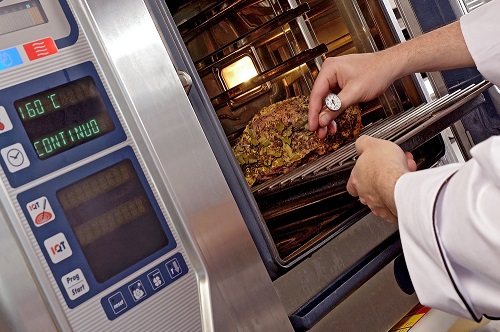From bakeries and cafes to fine-dining and quick-service restaurants, ovens are found in a wide variety of commercial kitchen applications. Some of the latest options on the market feature cutting-edge technology designed to reduce waste, high energy consumption and downtime.
While some of these trends mainly impact operators, they also affect how service companies and technicians work on new ovens. Customers call on local agents to conduct planned preventative maintenance, troubleshooting and repairs throughout the year. That's why knowing the new equipment features is crucial for proper service.
We'll break down two of the biggest commercial oven trends and how they could impact service companies.
Multiple Cooking Capability
 Multiple cooking options in a single unit reduces the footprint in a kitchen..
Multiple cooking options in a single unit reduces the footprint in a kitchen..
Select manufacturers are trying to make life easier in various ways, including finding ways to reduce space in a kitchen by creating a single unit that can combine multiple ovens into one footprint. That way, if an operator needs to cook various products using different cooking modes, they don't have to crowd their kitchen with various types of ovens.
Multi-function ovens allow commercial kitchens to do numerous types of cooking from one unit. Depending on the model, a user can have the option to flip from convection, steam, combi, holding and more. As we saw at the 2022 National Restaurant Association Show, one Kitchen Innovation award winner has mastered a technology to cook multiple products while running different cooking modes at the same time. The design uses separate chambers in the same oven to pull this off, helping save space and time.
What does this mean for service companies? The nuts and bolts behind the technology might sound like you need an engineering degree, but the good news is that they're mostly the same to service. Most of the machine should have the same basic footprint and parts inside the unit. However, technicians should read up on the day-to-day operation of the unit and its technology so they're better equipped to conduct troubleshooting and repairs.
Smart Operation
 Some new ovens feature smart capability that send users alerts to other devices.
Some new ovens feature smart capability that send users alerts to other devices.
Commercial smart ovens have been available in the space for the last few years, but they're starting to grow in popularity because of their easy user interfaces and ability to track various statistics. Thanks to the Internet of Thing (IoT) and cloud-based software solutions, oven operators can easily monitor everything from cook and hold times on convection models to water consumption on steam and combi units.
This technology also simplifies operating the equipment by providing alerts even when a user is away from the unit. Whether a change has occurred in a cooking phase or cycle or if a task needs to be performed, such as removing product, performing a preventative maintenance task or replacing cleaning chemicals, a notification can be sent right to the user's phone.
What does this mean for service companies? While smart technology can make life easy for operators, it can significantly improve diagnostics for field technicians, too. The latest commercial ovens are becoming more accurate at identifying broken components and predicting critical failure. This should be music to the ears of many service companies, especially authorized service agencies. Why? With access to a customer's machine, a service agent can be alerted when a part is failing and quickly remedy the issue. This not only reduces the amount of troubleshooting and equipment downtime but also enhances the service call's accuracy, which helps service agents build a better relationship with their customers.



